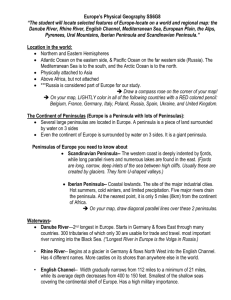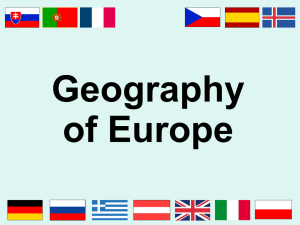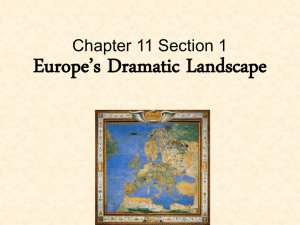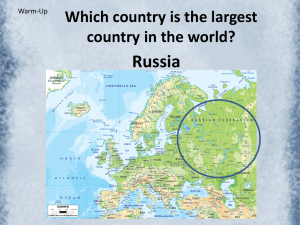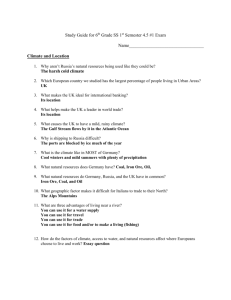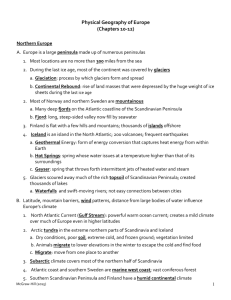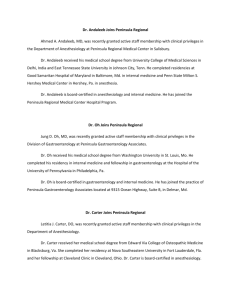File
advertisement
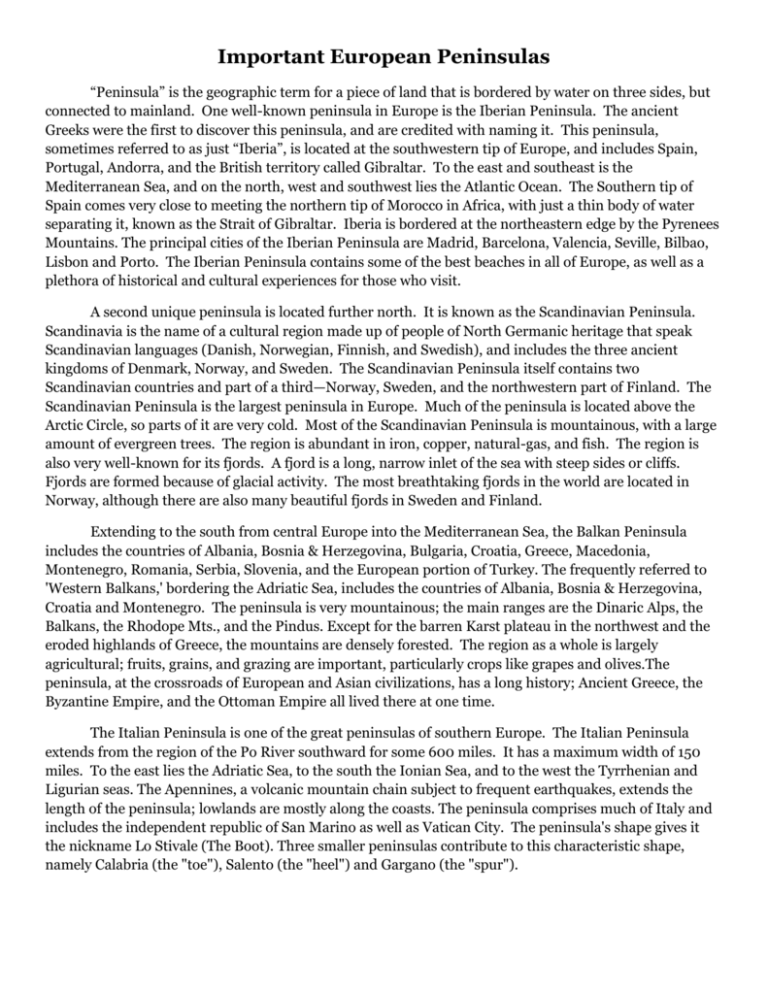
Important European Peninsulas “Peninsula” is the geographic term for a piece of land that is bordered by water on three sides, but connected to mainland. One well-known peninsula in Europe is the Iberian Peninsula. The ancient Greeks were the first to discover this peninsula, and are credited with naming it. This peninsula, sometimes referred to as just “Iberia”, is located at the southwestern tip of Europe, and includes Spain, Portugal, Andorra, and the British territory called Gibraltar. To the east and southeast is the Mediterranean Sea, and on the north, west and southwest lies the Atlantic Ocean. The Southern tip of Spain comes very close to meeting the northern tip of Morocco in Africa, with just a thin body of water separating it, known as the Strait of Gibraltar. Iberia is bordered at the northeastern edge by the Pyrenees Mountains. The principal cities of the Iberian Peninsula are Madrid, Barcelona, Valencia, Seville, Bilbao, Lisbon and Porto. The Iberian Peninsula contains some of the best beaches in all of Europe, as well as a plethora of historical and cultural experiences for those who visit. A second unique peninsula is located further north. It is known as the Scandinavian Peninsula. Scandinavia is the name of a cultural region made up of people of North Germanic heritage that speak Scandinavian languages (Danish, Norwegian, Finnish, and Swedish), and includes the three ancient kingdoms of Denmark, Norway, and Sweden. The Scandinavian Peninsula itself contains two Scandinavian countries and part of a third—Norway, Sweden, and the northwestern part of Finland. The Scandinavian Peninsula is the largest peninsula in Europe. Much of the peninsula is located above the Arctic Circle, so parts of it are very cold. Most of the Scandinavian Peninsula is mountainous, with a large amount of evergreen trees. The region is abundant in iron, copper, natural-gas, and fish. The region is also very well-known for its fjords. A fjord is a long, narrow inlet of the sea with steep sides or cliffs. Fjords are formed because of glacial activity. The most breathtaking fjords in the world are located in Norway, although there are also many beautiful fjords in Sweden and Finland. Extending to the south from central Europe into the Mediterranean Sea, the Balkan Peninsula includes the countries of Albania, Bosnia & Herzegovina, Bulgaria, Croatia, Greece, Macedonia, Montenegro, Romania, Serbia, Slovenia, and the European portion of Turkey. The frequently referred to 'Western Balkans,' bordering the Adriatic Sea, includes the countries of Albania, Bosnia & Herzegovina, Croatia and Montenegro. The peninsula is very mountainous; the main ranges are the Dinaric Alps, the Balkans, the Rhodope Mts., and the Pindus. Except for the barren Karst plateau in the northwest and the eroded highlands of Greece, the mountains are densely forested. The region as a whole is largely agricultural; fruits, grains, and grazing are important, particularly crops like grapes and olives.The peninsula, at the crossroads of European and Asian civilizations, has a long history; Ancient Greece, the Byzantine Empire, and the Ottoman Empire all lived there at one time. The Italian Peninsula is one of the great peninsulas of southern Europe. The Italian Peninsula extends from the region of the Po River southward for some 600 miles. It has a maximum width of 150 miles. To the east lies the Adriatic Sea, to the south the Ionian Sea, and to the west the Tyrrhenian and Ligurian seas. The Apennines, a volcanic mountain chain subject to frequent earthquakes, extends the length of the peninsula; lowlands are mostly along the coasts. The peninsula comprises much of Italy and includes the independent republic of San Marino as well as Vatican City. The peninsula's shape gives it the nickname Lo Stivale (The Boot). Three smaller peninsulas contribute to this characteristic shape, namely Calabria (the "toe"), Salento (the "heel") and Gargano (the "spur"). The Volga River In Russian folklore, the Volga River is mother and mistress, comrade and beloved companion and subject of tall tales. For today's Russia, it remains all of the above and an important source of water, power and transport. The Volga River is the longest river in Europe. Its basin lies entirely within Russia, and the Russian people frequently refer to it as the “Mother Volga.” It is thought of as the life blood of Russia, as over 40 percent of Russia's people live near it and its tributaries. Well over half of Russia’s farmers farm near the Volga, as well as over half of Russia’s factories. Thus, is a tremendous source for Russia’s economy, food supply, and livelihood. Stretching 2,300 miles, the Volga is about the length of the Mississippi and the longest river in Europe. It rises out of swamps northwest of Moscow in the Valdai Hills. Fed along its way by lakes and smaller rivers, it expands to become the mighty Volga, wending its way through Russia's heartland and eventually flowing south to the Caspian Sea. Eleven of Russia's 20 largest cities are located on the Volga. The population of these cities relies on the Volga tremendously. In fact, over 90 percent of Moscow’s water comes directly from the Volga. If the Volga is to remain the nation's pride — and lifeblood — it needs care. Forests along the river are being cut, affecting the river. Smaller rivers feeding the Volga are drying up, reducing the water supply. When water levels decrease, there are looming problems, including stagnant water that is unhealthy to consume. All of the industries, boats, and people that come in direct contact with the Volga play a role in polluting the river. Ural River The Ural River runs through the countries of Russia and Kazakhstan. The Ural is 1,509 miles long. It starts in the Ural Mountains at Mount Kruglaya. It runs through the mountains, farmland, and an area of desert before entering the Caspian Sea. Together with the Ural Mountains, the Ural River is considered to be a traditional boundary between Europe and Asia. The Ural River has played an important role throughout history, particularly in Kazakhstan. Not only is it a transport route to and from Russia for oil, fish, lumber, grain, and cattle, but it also is a source of water supply for many towns and agricultural areas in western Kazakhstan. The part of Kazakhstan west of the River is considered to be part of Europe. Thus, having the Ural as a boundary has put Kazakhstan in a very unique position in the world—it is both a European and Middle Eastern country. The country serves as a gateway to both regions. The Thames River Starting as a small trickle in the Cotswolds in England, the Thames River, or the “River Thames” travels over 210 miles through the heart of some of England’s most picturesque towns, right into the center of London and eventually, out into the North Sea. The River Thames takes its name from the Sanskrit language meaning “dark,” as its waters are often dark and cloudy. The River Thames has been an important trade route throughout its history, starting with the ancient Romans. In fact, it is believed that part of the reason why the Romans built London where they did was because of its location on the Thames. The Thames experienced serious pollution problems prior to London’s sewer system’s construction. In fact, in 1858, the stench from the river was so overpowering that Parliament had to be suspended, causing the government decided to find a way to rid the Thames of sewage. Today, the Thames still remains the most important waterway in England. It supplies water to numerous cities and millions of people. Additionally, it is important for England’s tourism as well. People from all around the world visit London to see its famous sites, such as the London Eye Ferris wheel and Westminster Bridge, both of which are located on the River Thames. The Rhine River The Rhine River , whose name comes from the Celtic word “renos”, meaning raging flow, begins at the Rheinwaldhorn Glacier in the Swiss Alps and flows north and east approximately 820 miles. The Rhine flows through Switzerland, Austria, France, Germany, and the Netherlands, until it reaches its mouth at the North Sea. Because of the multi countries and languages spoken along the Rhine, the river has four names. They are: Rhein in Germany; Rhine in France; and Rijn in the Netherlands (Dutch); Rhenus in ancient times. The Rhine is famous for its beautiful waterfalls, gorges, as well as its source of livelihood for many Europeans. Travelling along the Rhine in Germany, one can see some of the most spectacular castles in the world, built during medieval times. The Rhine has always been an important river historically. Many Germanic tribes settled around the river in early historic times. As time has gone on, kingdoms and cities were built with the intention of being near the Rhine. Wars were fought over territory along the river. In fact, Adolf Hitler made a very controversial decision prior to the start of World War II by entering the Rhineland, which Germany had been forbidden to do by the Treaty of Versailles. Today, the Rhine is widely known as one of the most beautiful rivers in the world, particularly for its scenic views and vast history. The Danube River The Danube River is the second longest river after the Volga. It starts in the Black Forest of western Germany and flows for some 1,770 miles to its mouth on the Black Sea. Along its course, it passes through nine countries: Germany, Austria, Slovakia, Hungary, Croatia, Serbia, Bulgaria, Romania, and Ukraine. The Danube has a picturesque, winding course, passing through low, forested mountains, rich farmland, and many historic cities. Probably most scenic is the Austrian section upstream from Vienna. On the border between Serbia and Montenegro and Romania, the Danube flows through a narrow gorge called the Iron Gate. At its mouth the river crosses a large, marshy delta in three main distributaries. The Danube is well developed as a transportation route. The Danube has long provided the chief corridor between central and southeastern Europe. For centuries, however, transit was periodically blocked or impeded due to rivalries among the various nations along the river. This was particularly true during the World War I and World War II time periods. Today, as countries in Europe are far more unified than ever before, the Danube is a very valuable transportation route for people and goods. Physical Features of Europe 1. Two important European peninsulas (choose 2): _____________________ Peninsula o What countries are part of the peninsula? o What bodies of water border it to make it a peninsula? ______________________ Peninsula o What countries are part of the peninsula? o What bodies of water border it to make it a peninsula? 2. Two important European Rivers (You choose 2 to read about) ___________________ River o Where does the river start? Where does it end? o The river runs through what country/countries? o What is one fact related to the river (length, economic uses, animal life, big cities located near it, etc.)? ___________________ River o Where does the river start? Where does it end? o The river runs through what country/countries? o What is one fact related to the river (length, economic uses, animal life, big cities located near it, etc.)? 3. Two important European mountain ranges (you choose 2): ______________ Mountains o Where is the mountain range located (what countries border or contain the mountains)? o What is the highest point in the range, and what is its elevation? ______________ Mountains o Where is the mountain range located (what countries border or contain the mountains)? o What is the highest point in the range, and what is its elevation? 4. Two important European seas (you choose 2). ________________________ Sea o List at least TWO countries that border the sea. ________________________ Sea o List at least TWO countries that border the sea.
